Do air purifiers use a lot of electricity? If you are also one of those people who have this concern, don’t worry! You are at the right blog post. Here, I will unveil about electricity consumption and how to calculate your bills. So without any delay, let’s head on to the details!
Quick Answer
To quickly overview, here is a rundown of air purifier’s energy consumption:
- If you want to clean the air in a large room, the purifier with a larger coverage area will cost around $8.7/month.
- For a medium size room, the cost is reduced to $6.65 /month.
- The small-sized room will cost you $2.4/month.
Read Also: Best Air Purifier for Home: 7 Great Models for Healthy Air
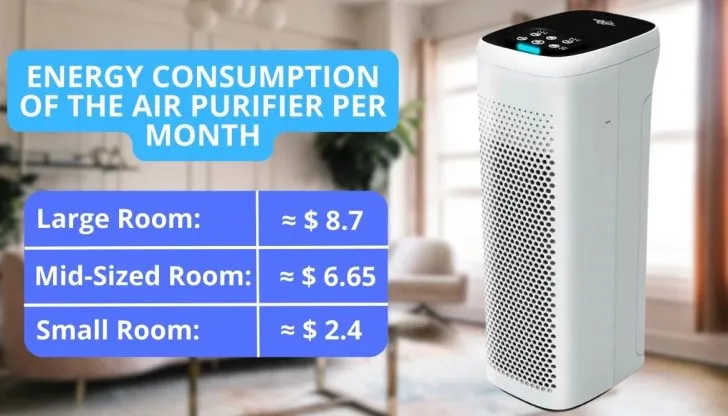
However, these are the basic calculations. Continue reading to learn how you can calculate about air purifier’s electricity consumption. Also, get insights into the power consumption of different brands’ purifiers and 7 helpful advice to help you with energy saving.
Do Air Purifiers Use a Lot of Electricity and Do Air Purifiers Increase Electric Bill?
When making an investment in cleaner air, you need to know how the device affects your monthly energy cost. The following formula for air purifiers can be used to calculate power consumption:
Power consumed = (wattage x cost per kWh x time (hours)) / 1000
To better understand this formula, let’s break it down:
- Wattage: This is the power rating which is commonly expressed in watts (W). It shows the maximum amount of power that the gadget uses when it runs at its fastest pace.
- kWh Cost: is an abbreviation for “kilowatt-hour cost,” which refers to the price that you are charged for one kilowatt-hour (one unit) of energy. The United States has an average national cost of $0.12 per kWh.
- Time (Hours): This displays the total number of hours that the air purifier is active on a daily basis.
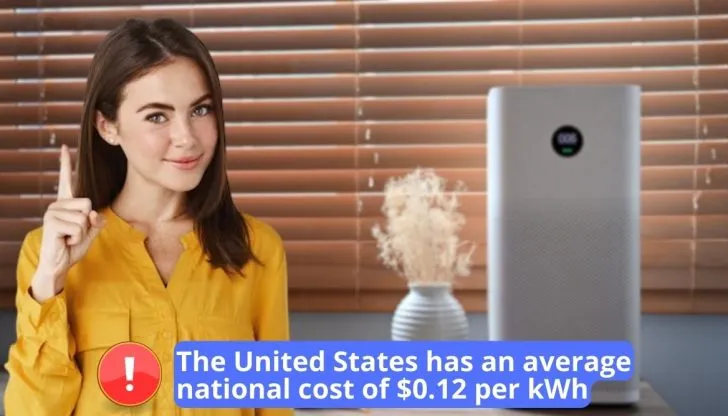
Let’s have a look at an example to help you understand better how much electricity an air purifier uses.
A Practical Illustration of An Air Purifier Wattage and Consumption
I’ll demonstrate the energy consumption and financial implications of an average air purifier that is equipped with a 50W motor. I’ll assume that your device comes with the standard three levels of fan speed settings:
- Low Speed: 10W;
- Medium Speed 25W;
- High Speed: 50W.
Electricity Bill
Let’s figure out how much it would cost each month electricity bill to operate these energy-efficient air purifiers nonstop at their maximum speed to improve indoor air quality:
- First, let’s calculate the daily usage, which comes out to be 1200W (50W x 24 hours).
- Then translate this into kilowatts: 1200 W divided by 1000 is 1.2 kW.
- Now compute the monthly usage, which comes out to be 36 kWh (1.2 kWh x 30 days).
- Lastly, let’s calculate the monthly expense: 36 kWh x $0.12 = around $4.3.
Large Room Air Purifiers: The Energy Consumption Footprint
Most air purifiers classified as large room air purifiers can cover more than 400 sq ft. Let’s examine the Blueair Classic 680i, known for its exceptional performance and renowned as one of the best air purifier models for big rooms.
Read Also: Do Smart Plugs Save Energy? Check the Truth Right Now!
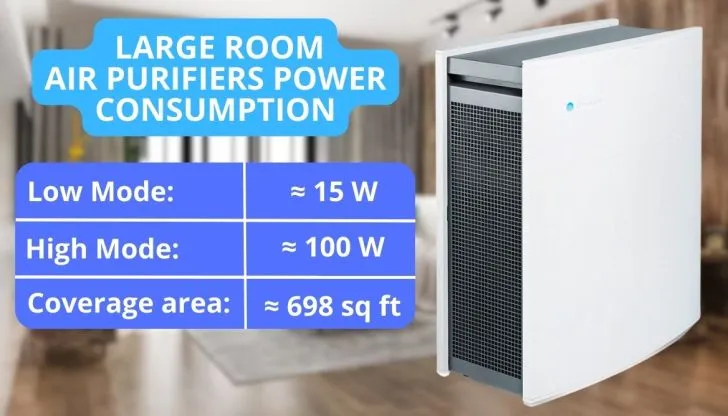
- This air purifier is designed for big rooms, with a suggested coverage area of 698 square feet and a very high 450 CADR rating.
- It uses fifteen watts of power at low fan speed.
- Running at high fan speed requires 100 watts.
Here’s how to figure out the maximum amount of power that may be consumed:
Property | Value |
High speed consumption: | 100 W = 0.1 kW |
Low speed consumption: | 15 W = 0.015 kW |
Time: | 24 hours |
Cost: | $0.12 per kWh |
1. High speed
If a large 100W air purifier is used for the whole 24 hours, it will cost $0.29 every day and $8.6 monthly:
Formula = 0.1 x 24 x 0.12 = $ 0.29 (daily) х 30 = $8.7 (monthly)
2. Low Speed
The wattage is 15W when the fan is set to a low speed, and the cost of the power for one day is $0.04, and for the whole month will be $1.29:
Formula = 0.015 x 24 x 0.12 = $0.04 (daily) x 30 = $1.29 (monthly)
Medium Room Air Purifiers: How Much Power Does it Use?
Let’s consider the Coway AP-1512HH Mighty, one of the most well-liked and high-performing models. It can purify rooms of area up to 361 sqft and consumes only 77 watts while operating at the highest settings.

Let’s examine its daily and monthly energy consumption in the highest setting:
Property | Value |
High speed consumption: | 77 W = 0.077 kW |
Time: | 24 hours |
Cost: | $0.12 per kWh |
To calculate the cost, you need to multiply kilowatt hours by the time of use and the electricity rate. So If you use such an air purifier for a whole day at maximum settings, it costs $0.22 every day:
Formula = 0.077 x 24 x 0.12 = $0.22 (daily)
That amounts to $1.55 every week and $6.65 monthly:
And 0.22 x 7 = $ 1.55 x 4.3 = $6.65 (monthly)
Small Room Air Purifiers: How Much Power Does it Use?
For a better understanding, let’s take a look at the Levoit LVH132 HEPA air purifier:
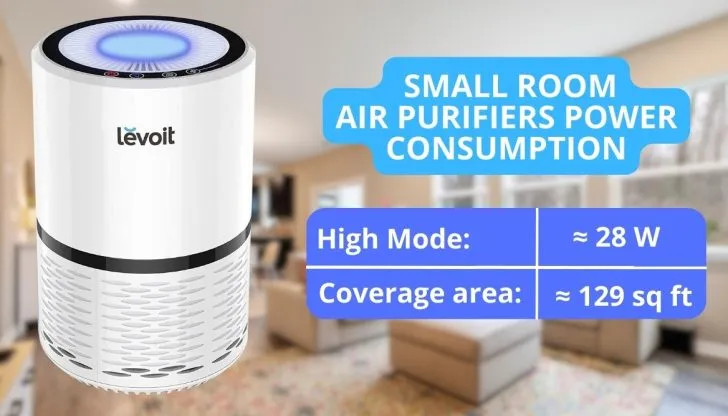
- Air purifiers for small rooms have the lowest operating costs.
- Its optimum coverage area is 129 square feet, and its maximum wattage is 28.
This is how the cost of energy is calculated:
Property | Value |
High speed consumption: | 28 W = 0.028 kW |
Time: | 24 hours |
Cost: | $0.12 per kWh |
The daily consumption of a small room air purifier is about $0.08:
Formula = 0.028 x 24 x 0.12 = $ 0.08 (daily)
Let’s compute the energy consumption:
- Per week: $0.56; ($0.08 x 7)
- Per month: $2.40; ($0.08 x 30)
- Per year: $29.03. ($0.08 x 365)
This shows that air purifiers consume very little energy when operating. For more insights into how much electricity an air purifier uses, check out this helpful video.
Exploring the Factors For Power Efficiency in Air Purifiers
Let’s look at the variables that impact the levels of power consumption that take place. The following are some important things to think about:

1. Size and Coverage Area
These units are greatly influenced by both their size and the area they can clean. Larger purifiers meant for larger areas could use more power than smaller models meant for smaller spaces.
2. Fan Speed and Settings
You will see many models that come in a variety of modes and speeds suited to your needs. The higher the fan speed will be, the more electricity it will consume as it needs to do more work. Energy use and performance must be balanced based on your needs.
3. Usage Duration
You also need to consider how long you want your device to run. When using Automode, it will run at a low speed and when the air quality is low, it will turn up. This will save you electricity consumption in the long run. Use timers or clever features to adjust operating hours based on air quality.
4. Type and Condition of Filter
Air purifiers employ a range of filters, including HEPA, Activated Charcoal, and Ionizing UVC filters. The kind of filters you will use and in what condition they are can also impact usage. If the filters are clogged, dirty, and worn out, the air purifier will require more electricity.
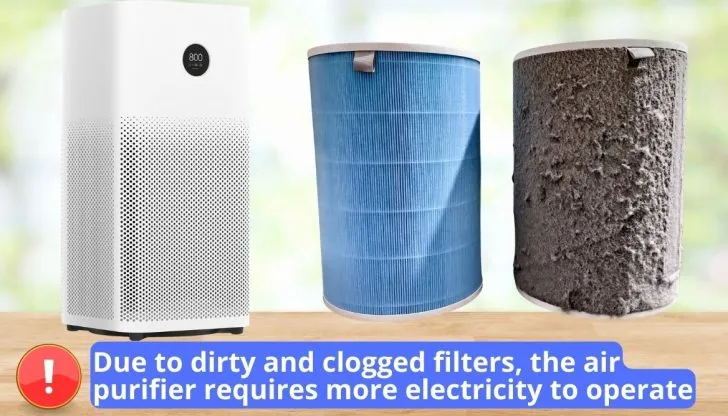
5. Add-ons
Different features that can be accessorized such as UV-C filtration, are additional electricity users due to their power-hungry nature. Most of the time, UV-C light doesn’t use much power, but if you truly want to lessen your bills then you should give this a thought.
6. Air Quality
If the interior air quality is very contaminated then you will need to run your device for longer periods of time to reach optimal levels of air. An increase in power usage may follow from this. The burden of the air purifier can be decreased by routinely checking and enhancing the general quality of the air in your area.
A Comprehensive Guide to Various Air Purifiers and Their Energy Usage
The following are some popular kinds of air purifiers:
1. HEPA Filter Air Purifiers
Though these are the set standard for most purification devices, they excel at capturing many airborne particles. In general, HEPA air purifiers use a considerable amount of energy. They consume generally around 50-200 watts of electricity.
2. Activated Carbon Filter Air Purifiers
These air purification devices are highly effective in eliminating pollutants, smells, and volatile organic compounds (VOCs). Because more steps are needed to capture and absorb harmful particles, these filters use more energy to operate than HEPA filters. The consumption can range anywhere from 100-400 watts.
Read Also: Shark Air Purifier 4 vs 6: Which is the Best for Your Needs
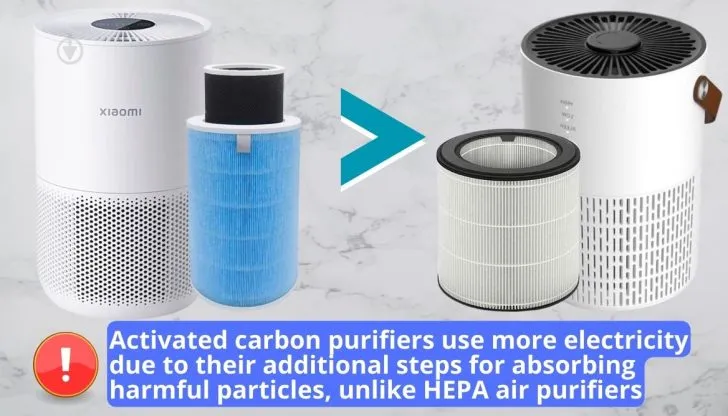
3. UV-C Light Purifiers
To eliminate bacteria, viruses, and other pathogens, UV-C light is utilized in air purifiers. Although air purifiers are quite powerful at destroying germs, they often use less energy since UV-C light doesn’t need a lot of electricity. They need less energy from 20-60 watts.

4. Ionic Air purifiers
Ionic air purifiers draw in and hold onto airborne pollutants using charged ions. Because these purifiers don’t need fans or filters, they use less energy. It’s crucial to remember that certain ionic purifiers release trace levels of ozone, which may be harmful to people who have respiratory disorders. They utilize about 5-50 watts.
5. Ozone Generators
These are specialty air purifiers that create ozone to get rid of offensive odors and destroy mold and germs and generally require higher energy levels. Ozone generators should not be used in households as they will be gobbling up the power units and possible health hazards from ozone exposure. The energy use can be from 100-800 watts.
A Deep Dive of Energy Use Across Top Brands
Let’s look at electricity consumption trends across different companies and see which provides with most energy-efficient air purifier.
Brands | Wattage | Monthly Cost in $(12/7) |
Levoit | 15-55 | 0.7-2.4 |
Medify | 18- 95 | 0.8- 2.4 |
Winix | 55-90 | 2.4- 3.9 |
Okaysou | 25- 50 | 1.1- 2.2 |
Austin Air | 132- 135 | 5.7- 5.8 |
Alen | 45- 105 | 2-5 |
Now that we have gone through the table, let’s explore the important details!
1. LEVOIT
The power consumption of LEVOIT air purifiers varies based on the model and ranges from a minimum of 15 to a maximum of 55 watts. This results in a cost of $0.7 to $2.4 monthly associated with using a LEVOIT Air Purifier for 12 hours a day will come to between anywhere from $0.7 to $2.4.
2. Medify
It should be noted that the Medify air purifier when run for 12 hours per day will be utilizing around 8-95 watts. As a result, this comes out to an electrical cost of from 80 cents to $4.

3. Winix
Around 55 to 90 watts of electricity consumption can be expected from these cleaning units contingent on the model. So you will be spending between 2.4 and 3.9 dollars in electricity bills per month if it is operated for 12 hours daily.
4. Okaysou
The amount of consumption varies depending on the model but generally speaking, you should expect from 25-50 watts of power to be consumed. This implies that the monthly electricity costs associated with running an Okaysou air purifier for 12 hours a day will come to between 1.1 and 2.2 dollars.

5. Austin Air
If you want to run these devices you should expect usage of between 132 and 135 watts of power, depending on the model. This indicates that the monthly power expenditures associated with running an Austin air purifier for 12 hours a day will come to anywhere from $ 5.7 to 5.8.
6. Alen
On the highest level of speed fan, these air purifiers (depending on the model) utilize around 45 to 105 watts. This implies that if you run your device for 12 hours around the clock then monthly electricity expenses would range from $2 to $5.

A Quick Guide to Saving Energy and Breathing Easy!
Let’s look at some of the ways in which you can minimize your consumption levels and keep the bills at bay:
1. Pre-Filter Cleaning
Here is what you need to know about how cleaning these filters can help you out:
- Maintaining the energy efficiency of your air purifier requires routinely cleaning the pre-filter at least once a month.
- If you have a dusty climate or have furry pets then I would recommend seeing the condition of the filter every week and giving it a thorough cleaning.
- Keeping your pre-filter clean is critical to keeping your air purifier operating at peak efficiency and avoiding overuse of power and labor. Clogged filters can increase your energy usage by up to 15%!
- It is also suggested to replace them every three months.
You will learn how to clean the filter properly in this video:
2. Maximizing Auto Mode
Here’s how an auto mode can help use less electricity:
- Air quality monitors are a feature of many contemporary air purifiers. This sensor continuously takes a sample of the room’s air to measure its quality and adjust the fan speed.
- The fan will automatically reduce its speed when the air quality is fine. This automated method maximizes the effectiveness of air purifiers.
- To maintain accuracy, air quality sensors need to be cleaned often. If dust is accumulated on the sensor, your air purifier may continue to run continuously.
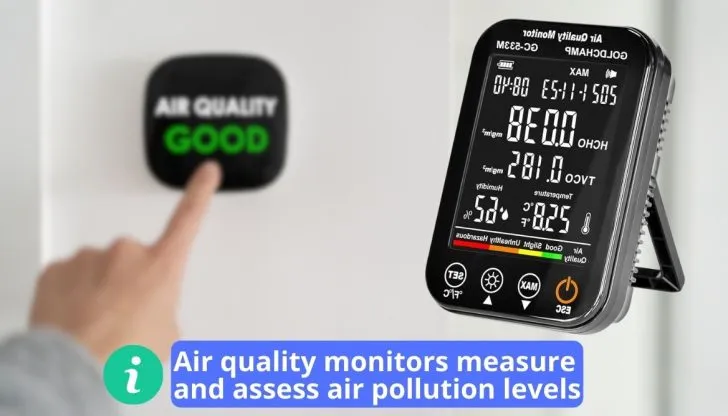
3. Placement
Here’s how to place an air purifier so that it doesn’t use a lot of electricity:
- Although many air purifiers can be positioned against a wall, it is advisable to place the device in a central area whenever feasible.
- By having this feature, the air purifier is able to effectively draw in air from every corner of your room, resulting in a swift and thorough cleaning process.
- Ideally, keep it 3-5 feet above the ground for optimal cleaning.
- You should have at least a minimum of 3 feet of space around the purifier for it to do its job perfectly.
Watch the helpful video “Air Purifiers Location Guide. Where Should I Place My Air Purifier?”
Read Also: Best Air Purifier for the Bathroom: 7 Great Models for Odors-Free Space
4. Keeping the Doors and Windows Shut
Let’s see how air ventilation plays a role in energy consumption:
- Air purifiers do not produce fresh air on their own. The air in your room is purified and then returned to you.
- To enhance the interior quality of air, I advise keeping the doors and openings shut. This helps the air purifier to not encounter any additional external pollutants.
- The air quality should improve when you have used the device for at least 1-3 hours. Once you notice the difference in the clean air then, you can lower the air purifier’s fan speed for energy efficiency.
5. Low Setting Running
To maximize your settings for the best consumption rates, here is what you should do:
- When the unit runs on a high setting it will use more energy and similarly, it will be using less energy when used at a lower fan speed.
- Try several configurations to find the best balance between air purification efficiency and energy usage and at what rate electricity an air purifier consumes.
- In case you have guests over and you are cooking anything that has a strong smell then it would be better to turn on the Turbo settings.
- It is better to run your device on a ‘quiet’ setting on medium fan speed to keep the room’s air clean all through the day.
6. Ideal Running Time
Let’s explore the time duration of how long it should run in a day:
- Air purifiers are designed in such a way that they can be operated continuously 24 hours a day without any concerns.
- You may use an auto mode while running an air purifier as the purifier will keep running all around the day but if it detects unusually high levels of pollutants, it will turn on its high speed.
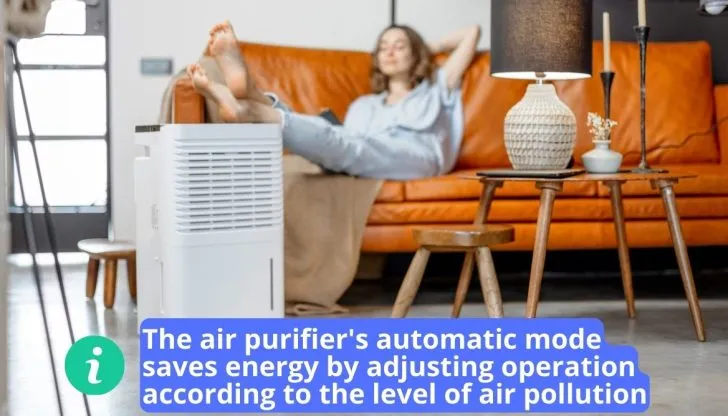
FAQs
Do air purifiers increase the cost of your power bill?
Yes, the air purifiers increase the cost of your power bill, but only by a couple of bucks. They will only cost you a mere $2- 9 monthly!
What is the daily cost of operating an air purifier?
The daily cost of operating an air purifier is $0.29 at max if you cover a large room at the highest speed.
Does energy save while using the auto mode?
Yes, the energy is saved while using the auto mode as it will run in an efficient manner only when the air quality is bad.
Is power saved during pre-filter cleaning?
Yes, power is saved during pre-filter cleaning, as more air can be cleaned leading to quicker run time, which will reduce power consumption and electricity bills.
Which air purifier uses the least amount of energy?
Energy Star certification air purifiers use the least amount of energy as they are designed to conserve as much energy as possible.
Conclusion
Let’s conclude! do air purifiers use a lot of electricity? No, they are fairly energy efficient and do not require a large amount of energy. The amount they consume will depend on the types of filters employed, speed settings, size of the unit, running time, and area it needs to filter.
You should expect around $9 dollars a month for a large room on the highest speed while around $2.4 dollars for covering a small room. Also, try to place them in the center of the room to optimize their efficiency, and keep them regularly cleaned and run at low speed throughout the day for maximum efficiency.
Recommended read:
Starlink Internet Coverage Map 2025 : Is Starlink Available in Your Area
Garmin Fenix 8 Release Date: Should You Expect It in 2025
Starlink Mesh Router: 8 Features and Is It Worth Its Money
Philips WiZ vs Hue: Which Is Better and Offers More Features
Apple Pencil 3 Release Date: Will it Be Available Soon
Reasons for Doorbell Transformer Buzzing and Their Solutions
How to Set Nest Thermostat to Hold Temperature: 4 Easy Methods!
Do Smart Plugs Save Energy? Check the Truth Right Now!
Roku vs Smart TV: Which One You Should Buy For Better Entertainment?
